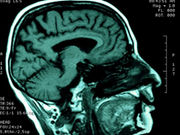Improvement noted in executive function in aerobic exercise group after six months
THURSDAY, Dec. 1, 2016 (HealthDay News) — For adults with mild cognitive impairment (MCI), an aerobic exercise intervention could preserve or improve brain volumes, according to a study presented at the annual meeting of the Radiological Society of North America, held from Nov. 27 to Dec. 2 in Chicago.
Laura D. Baker, Ph.D., from the Wake Forest School of Medicine in Winston-Salem, N.C., and colleagues acquired longitudinal magnetic resonance imaging (MRI) for 35 adults with MCI as part of a randomized controlled trial investigating an exercise intervention (16 participants received aerobic exercise, 19 received stretching control). Brain MRI was acquired at baseline and six months later, following the exercise intervention.
The researchers identified volumetric increases in most regions of the gray matter for both aerobic and stretching exercise groups (P < 0.05 with false discovery rate correction). In the stretching control, volumetric contraction was seen in right posterior corona radiata. Between the groups there were different volumetric increases around the genu of corpus callosum, right middle temporal gyrus, and bilateral superior frontal gyri, with higher volumetric expansions in the aerobic group. Similar patterns were seen in directional/shear deformation patterns, with volume changes in most statistically significant brain regions. After six months there was also improvement in executive function in the aerobic exercise group.
“Compared to the stretching group, the aerobic activity group had greater preservation of total brain volume, increased local gray matter volume and increased directional stretch of brain tissue,” a coauthor said in a statement. “Directional changes in the brain without local volume changes could be a novel biomarker for neurological disease. It may be a more sensitive marker for the tiny changes that occur in a specific brain region before volumetric changes are detectable on MRI.”
Copyright © 2016 HealthDay. All rights reserved.








